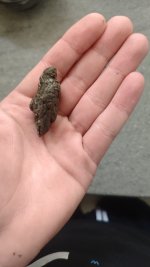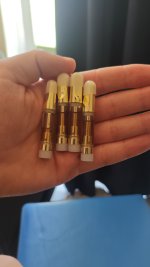The Method described uses no dangerous or illegal ingredients, and is Safer or at least as safe as a DMT extraction, this is for educational purposes only.
CBD isomerization to THC using zeolite clinoptilolite
pros: easy, no dangerous chemicals used.
cons: only around 50% of the CBD converts, so you will have a mixture of around 50% CBD & 50% THC.
ingredients:
1.CBD crystals 99%. (CBD is legal in most EU countries and the USA)
2.Zeolite clinoptilolite in powder form. (its categorized as a G.R.A.S substance by the United States Food and Drug Administration and is considered edible.)
3.ethanol (optional)
equipment:
1.Oven
2.aluminum foil
3.scale
how it works:
Zeolite is an aluminum silicon that has negatively charged anions, when CBD is heated at 105°C (221°F) to 150°C(302°F) the anions attract the CBD molecules causing them to rotate.
Usually for this to occur, dangerous acids or metal salts have to be used, But in this method we only use zeolite.
method: weight 1 gram of CBD crystals and 1 gram of zeolite clinoptilolite powder, mix them until they become a homogenous powder, now take a big piece of aluminum foil at least the size of 2 A4's,
put your powder in the center and start folding very tightly, you can make it a small ball to apply even more force, the reason we need it tight is to minimize the contact with oxygen as much as we can because oxygen (and water) interferes with the isomerization causing a lot of Δ8-THC to be produced and while Δ8-THC is found naturally in the cannabis plant and is psychoactive (although slightly less psychoactive than Δ9-THC) many people like their conversions to contain mostly Δ9-THC, after we make sure our aluminum foil is packed tightly we warm our oven for 10 minutes to 150°C (302°F), aluminum foil can safely be used in the oven up to 200°C (392°F).
once the oven starts to get close to 105°C (221°F), put your aluminum-packed powder in and set a timer to 15 minutes, once the 15 minutes pass take it out of the oven let it aside to cool, once it gets in a comfortable to touch temperature, carefully open it, you will find a black powder inside and you will think you burned it, but this is normal, the conversion should be complete.
edit: in case you decide to use the flame in Jar method to minimize oxygen in your reaction, remember that glass is very bad at conducting heat, so you will need to adjust the timeframe accordingly in order to allow the container to catch up the target temperature, in other words extent the duration of applied heat or start applying heat on the container before you start the timer, you will probably have to experiment and find what works best for you as far as heat goes, since different ovens and equipment (jars etc.) will produce variable outcomes.
!UNDER ANY CIRCUMSTANCES DO NOT SMOKE ZEOLITE! , however zeolite is edible.
how to get the THC/CBD mixture out of the zeolite(optional): here we will use ethanol, put your zeolite powder containing THC in a jar and add ethanol, if you made under 10 grams of powder add 10ml of ethanol per gram, you can lower the amount of ethanol used as you scale up in the amount of powder, the ethanol will dissolve your cannabinoids and then you have to filter the zeolite out, you can use coffee filters, filter 2-3 times, collect the filtered cannabinoid containing ethanol inside a clean jar and heat it using a hot water bath until all ethanol evaporates, even if you think all ethanol has evaporated heat it for more time or leave it open for 24 hours for safety, once the ethanol is evaporated, you will be left with a clear yellow to orange sticky compound.
Be aware that simple filtration could possibly
leave zeolite particles in the distillate which would make it dangerous to vape/smoke, i suggest that you simply
use your product orally if you are not sure about its purity.
key note:
1.You need pure CBD crystals for this, no crude oils, and no full spectrum extracts, impurities will lead to impurities.
2.You need zeolite clinoptilolite in powder form, no specific μm, just powder.
what does zeolite clinoptilolite do to the body according to NCBI:
"Zeolite clinoptilolite (ZC) reduces ammonia concentration and improves the integrity of the intestinal barrier. Furthermore, ZC acts on intestinal lymphoid tissues with a positive impact on the intestinal ecosystem and boosting the immune system."
source:
Zeolite Clinoptilolite: Therapeutic Virtues of an Ancient Mineral




 Disclaimer: I’m a hobbyist. Some steps may not be the most efficient, but they aim to be safe and beginner-friendly (in my opinion).
Disclaimer: I’m a hobbyist. Some steps may not be the most efficient, but they aim to be safe and beginner-friendly (in my opinion). Tip: Use foil sheets roughly the length of two A4 pages. Aim for a firm but flexible envelope.
Tip: Use foil sheets roughly the length of two A4 pages. Aim for a firm but flexible envelope. Expected result: dark powder
Expected result: dark powder Reality (for me): I always got something hash-like, not powdery.
Reality (for me): I always got something hash-like, not powdery. Tip: The stronger and sweeter the smell, the better the effect. Best batches have a brown/orange hash look. A greenish/gray hash is usually weaker—though not always. I once got a strong batch from an old oven where the result looked weak. Sometimes random luck beats logic.
Tip: The stronger and sweeter the smell, the better the effect. Best batches have a brown/orange hash look. A greenish/gray hash is usually weaker—though not always. I once got a strong batch from an old oven where the result looked weak. Sometimes random luck beats logic. Congrats! You now have active edible hash (THC/CBD mix). It’s already decarboxylated and ready to eat.
Congrats! You now have active edible hash (THC/CBD mix). It’s already decarboxylated and ready to eat.
